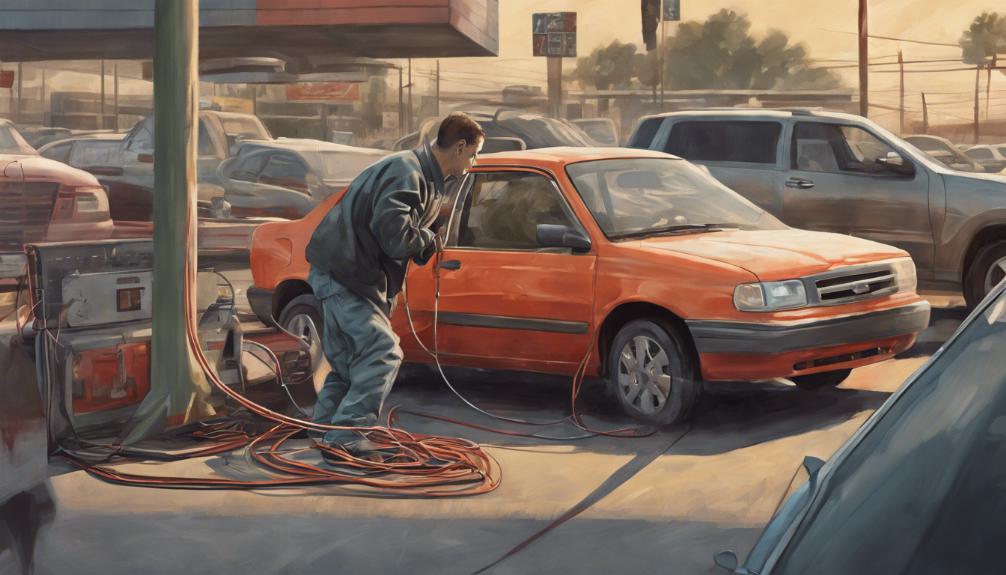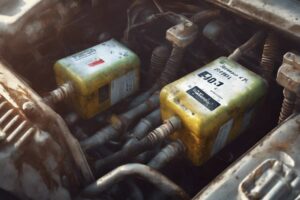When jump-starting your car, it usually takes 10 to 15 minutes. Factors like battery condition and weather influence the process duration, avoid insecure connections and insufficient charge time. Proper sequence and cable attachment are important for a quick jump-start. After, let both cars idle for 20 minutes. Start with red clamp on positive terminal, black on negative; then attach black clamp to dead car’s metal surface. Post jump-start, let your car run for at least 20 minutes. Driving for extra 15 minutes helps recharge the battery. Seek help if issues persist. Effective jump-starting techniques are essential for emergency situations.
What You Need to Know
- Jump-starting process typically takes 10 to 15 minutes, influenced by battery condition and weather.
- Proper connection technique: red clamp to positive, black clamp to negative, secure attachment crucial.
- Let both cars idle for 20 minutes post jump-start to maintain battery.
- Drive jump-started car for 15 extra minutes to allow alternator to charge the battery.
- Monitor battery status post jump-start, drive for 20 minutes to fully recharge, and regularly check for maintenance.
Duration of Jump-Starting Process

When jump-starting your car, the duration of the process typically ranges from 10 to 15 minutes to revive a dead battery successfully. Factors affecting this timeframe include the condition of the battery, the prevailing weather conditions, and the types of vehicles involved. Common mistakes that can prolong the jump-starting process include not ensuring a secure connection between the jumper cables and the battery terminals, as well as attempting to jump-start a severely depleted battery without allowing sufficient time for the charge to transfer.
It is essential to follow the correct sequence when connecting the jumper cables to shorten the overall duration of the jump-starting process. After successfully jump-starting the vehicle, it’s recommended to allow both cars to idle and run for an additional 20 minutes. This extended period enables the alternator to fully recharge the previously dead battery, ensuring it’s ready for future use. Remember, in some instances, multiple attempts may be necessary to revive a car with a severely depleted battery.
Proper Connection Techniques
To guarantee a successful jump-start, begin by attaching the red clamp to the positive terminal of the working battery. This step is vital in establishing a proper connection and ensuring the flow of electricity between the two vehicles. Safety precautions must be observed at all times during this process. Then, make sure the black clamp is connected to the negative terminal of the working battery. When connecting the black clamp to the dead car, make certain it’s attached to the negative post or a metal surface to prevent any accidents or damage.
Common mistakes during this step include attaching the clamps incorrectly, which can result in electrical issues or even damage to the vehicles. Securely attaching the jumper cables is essential to avoid accidents and ensure a successful jump-start. Following the correct sequence of cable removal after jump-starting is also important to prevent any harm to the vehicles’ electrical systems. By adhering to these proper connection techniques and safety precautions, you can effectively jump-start a car without any mishaps.
Running Cars Post Jump-Start

After jump-starting your car, make sure to let it run for at least 20 minutes to allow the battery to recharge fully. Running the car post jump-start is essential for battery maintenance. It provides the necessary time for the battery to regain its charge, ensuring it holds enough power for future starts.
Then, driving the jump-started car for an extra 15 minutes can help the alternator effectively charge the battery. These preventive measures contribute to the overall health of your vehicle’s electrical system.
If the jump-started car continues to experience starting issues even after running it, it may be wise to seek professional help. Continuous reliance on jump-starts without addressing underlying battery or alternator problems can lead to further complications down the line.
Is it possible to jump-start your car if the seat belt warning light is on?
If the understanding seat belt warning light is on when trying to jump-start your car, it may be due to a malfunction in the seat belt sensor. Before attempting to jump-start, make sure the seat belt is securely fastened and check the owner’s manual for troubleshooting steps.
Recharging Battery After Jump-Start
Begin monitoring your car’s battery status immediately post jump-start for best recharging. It’s important to drive your vehicle for at least 20 minutes after a jump-start to allow the alternator to fully recharge the battery.
This process helps replenish the energy used during the jump-start and maintains the battery’s longevity and performance. Continuous driving is essential as it aids in restoring the charge in the battery and maintaining its peak functionality.
Regularly checking the battery and electrical systems post jump-start is also recommended to prevent any potential issues in the future. Proper battery maintenance is key to ensuring that your car’s electrical systems operate efficiently and reliably.
Essential Skills for Emergency Situations

Mastering the art of safely jump-starting a car is an essential skill for handling emergency situations on the road. Safety precautions are paramount when dealing with a car battery. Always wear protective gear like gloves and safety glasses to shield yourself from sparks and battery acid.
Make sure the vehicles are in park or neutral with the engines off before beginning the jump-start process. Incorrect cable connections or a reversed sequence can lead to electrical damage in both vehicles. Common mistakes include forgetting to attach the negative cable to a clean, unpainted metal surface on the dead car instead of the battery.
Practice the correct jump-starting techniques to boost your confidence in case of a car battery emergency. Developing these essential skills not only saves time and money but also avoids the need for towing or professional assistance.
Be prepared for any roadside battery mishaps by mastering these fundamental jump-starting skills.
As an Amazon Associate we earn from qualifying purchases.










